
The Battle off Monserrat, 1805
21st October 2021, 4 Comments
The Age of Sail, Fighting Sail, 1/1200 scale
As it was 21st October – Trafalgar Day – there was only one type of game we could play. So, I dug out my Age of Sail ships, and Gyles, Mally, Sean and I took to the high seas. In theory this clash was set amid the Leeward Islands of the West Indies, somewhere between Monserrat, Guadaloupe and Antigua in June 1805, four months before Trafalgar. The idea was that part of the Franco-Spanish fleet had sailed from Martinique, bound for the Atlantic, and was intercepted by a British squadron waiting for it off Antigua. 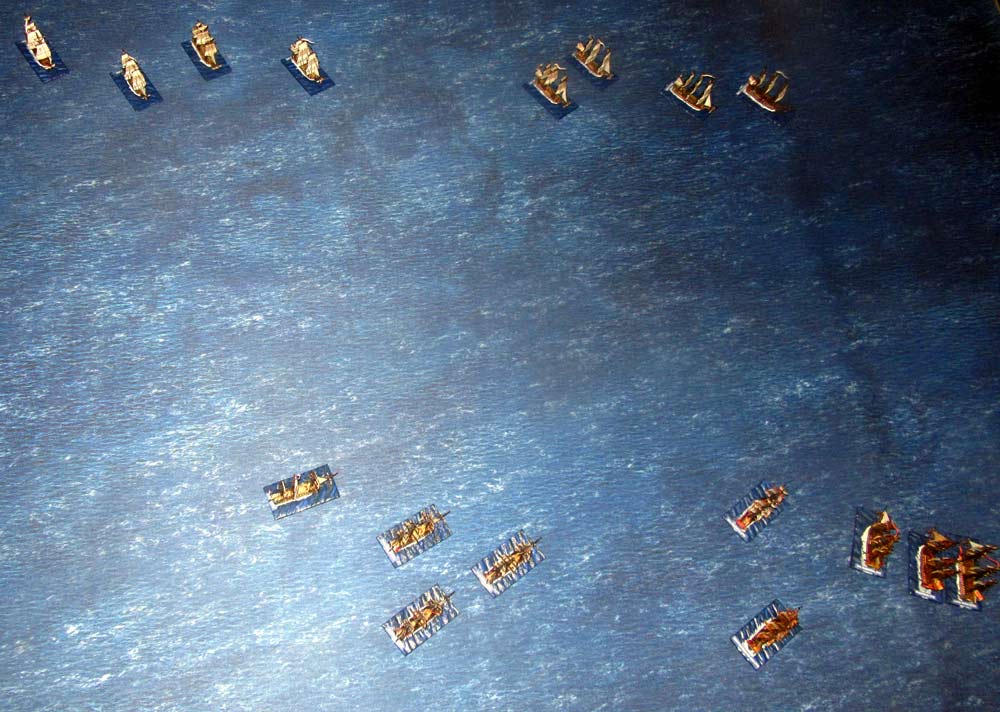 In this clash, Sean and Mally commanded the British, with a total of eight ships-of-the-line (shown at the top), while Gyles had the Spanish and I led the French, with five and four ships-of-the-line respectively. That’s us at the bottom, with the Spanish on the right. In this game, played out on a 6×4 foot table, the wind was coming from the west, and the British were to the north, and the French to the south. The broad expanse of the Atlantic lay some way to the east, beyond the leeward short table edge.
In this clash, Sean and Mally commanded the British, with a total of eight ships-of-the-line (shown at the top), while Gyles had the Spanish and I led the French, with five and four ships-of-the-line respectively. That’s us at the bottom, with the Spanish on the right. In this game, played out on a 6×4 foot table, the wind was coming from the west, and the British were to the north, and the French to the south. The broad expanse of the Atlantic lay some way to the east, beyond the leeward short table edge. 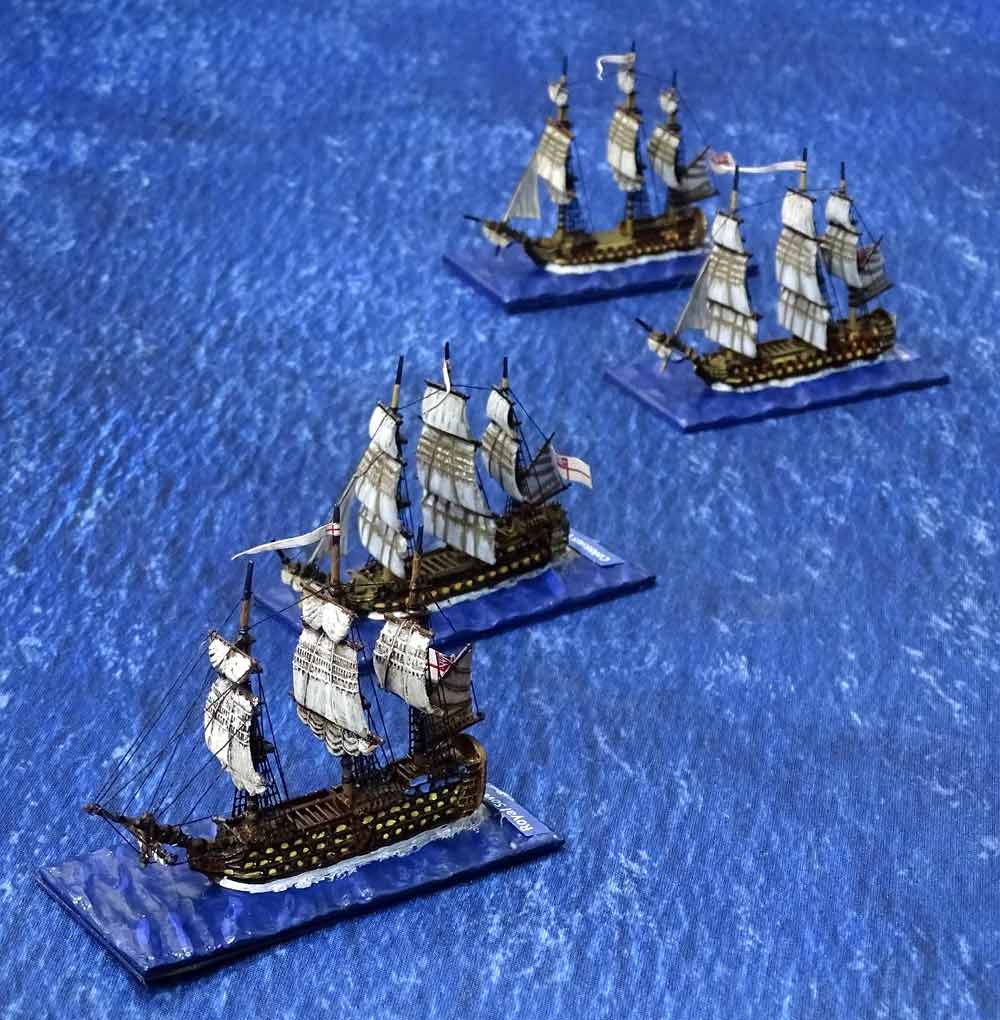 Now, this was our first time using Fighting Sail, from the Osprey rules stable. I’d read the rules a few years ago, and was put off by the way gunnery was so deadly – ships could be sunk in a single turn – and the references to “explosions”. Ships also didn’t sail properly, as there seemed no real penalty for sailing into the wind. Well, fear not. Fighting Sail is served by a Facebook group, and on it lurked a set of semi-official modifications. These really turned the rules around.
Now, this was our first time using Fighting Sail, from the Osprey rules stable. I’d read the rules a few years ago, and was put off by the way gunnery was so deadly – ships could be sunk in a single turn – and the references to “explosions”. Ships also didn’t sail properly, as there seemed no real penalty for sailing into the wind. Well, fear not. Fighting Sail is served by a Facebook group, and on it lurked a set of semi-official modifications. These really turned the rules around.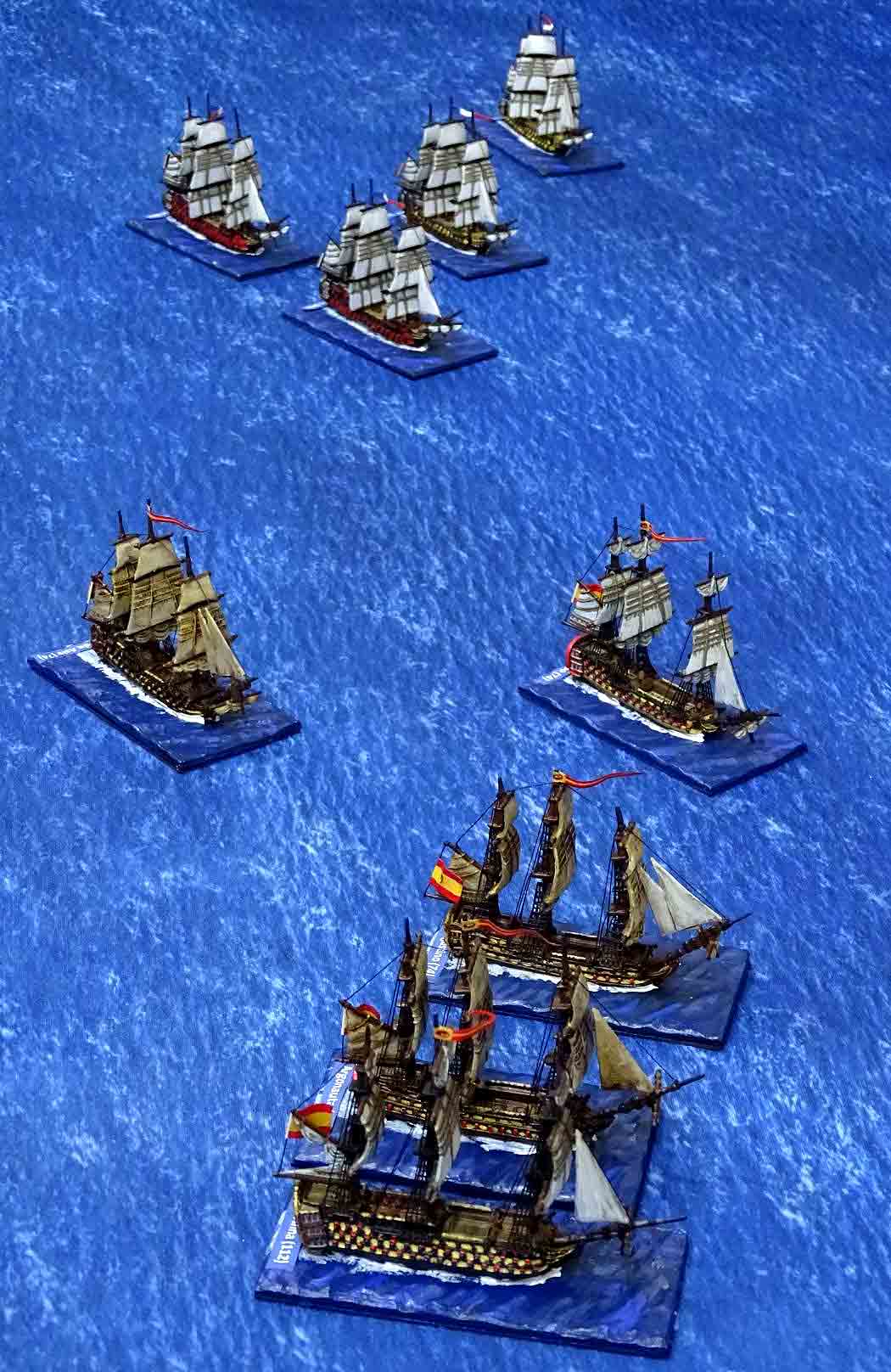 While still quite “arcadey”, it worked surprisingly well. Above all, everyone picked up the system’s quirks right away, and really enjoyed themselves – even when their ships struck their colours. We began with all four squadrons – four ships each (five for the Spanish) gently sloping towards their opponents. As the range closed it was clear that Sean’s vanguard squadron would find itself in action before the rear squadron could join in, That worked for us, but we were a little wary of Sean’s flagship Royal Sovereign, a 1st Rate of 100 guns. As benefits the period, the British had the edge in gunnery, but we planned to use our numbers to counter that.
While still quite “arcadey”, it worked surprisingly well. Above all, everyone picked up the system’s quirks right away, and really enjoyed themselves – even when their ships struck their colours. We began with all four squadrons – four ships each (five for the Spanish) gently sloping towards their opponents. As the range closed it was clear that Sean’s vanguard squadron would find itself in action before the rear squadron could join in, That worked for us, but we were a little wary of Sean’s flagship Royal Sovereign, a 1st Rate of 100 guns. As benefits the period, the British had the edge in gunnery, but we planned to use our numbers to counter that. 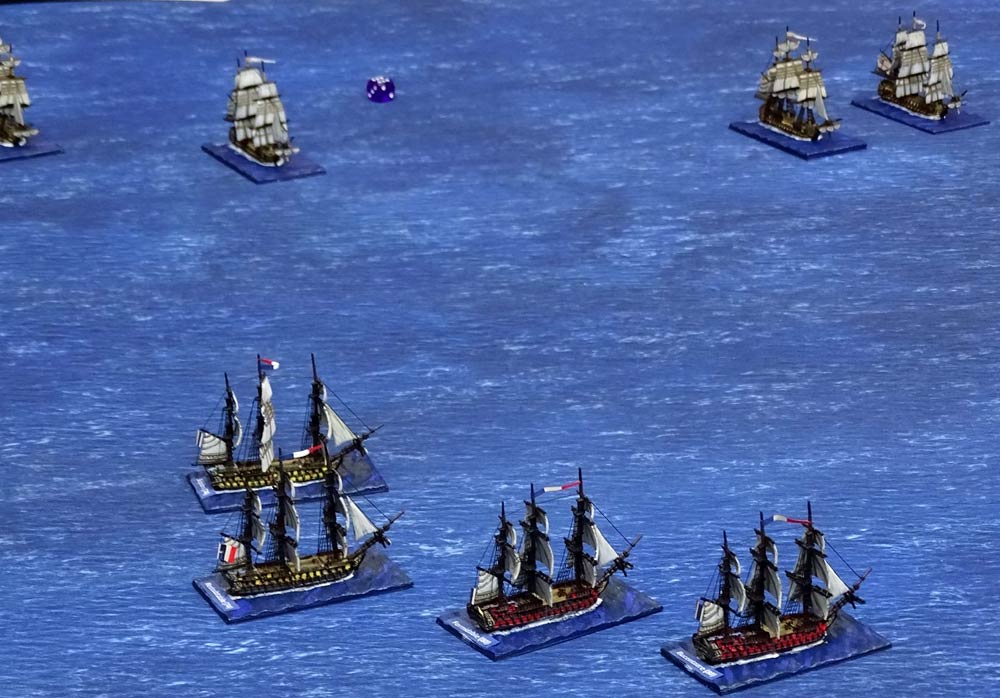 There wasn’t much of a neat lie of battle in this game – it was more like three gaggles of ships closing with each other. Don’t blame the rules though – with a bit of effort we could have formed up into a firing line. It was just us Allies were keen to gang up on the British vanguard before Mally’s squadron came up to join it. The battle began with some long-range gunnery, which chewed up the British a little, causing “anchor” hits. These hindered their sailing slightly – but not enough to make a real difference.
There wasn’t much of a neat lie of battle in this game – it was more like three gaggles of ships closing with each other. Don’t blame the rules though – with a bit of effort we could have formed up into a firing line. It was just us Allies were keen to gang up on the British vanguard before Mally’s squadron came up to join it. The battle began with some long-range gunnery, which chewed up the British a little, causing “anchor” hits. These hindered their sailing slightly – but not enough to make a real difference. 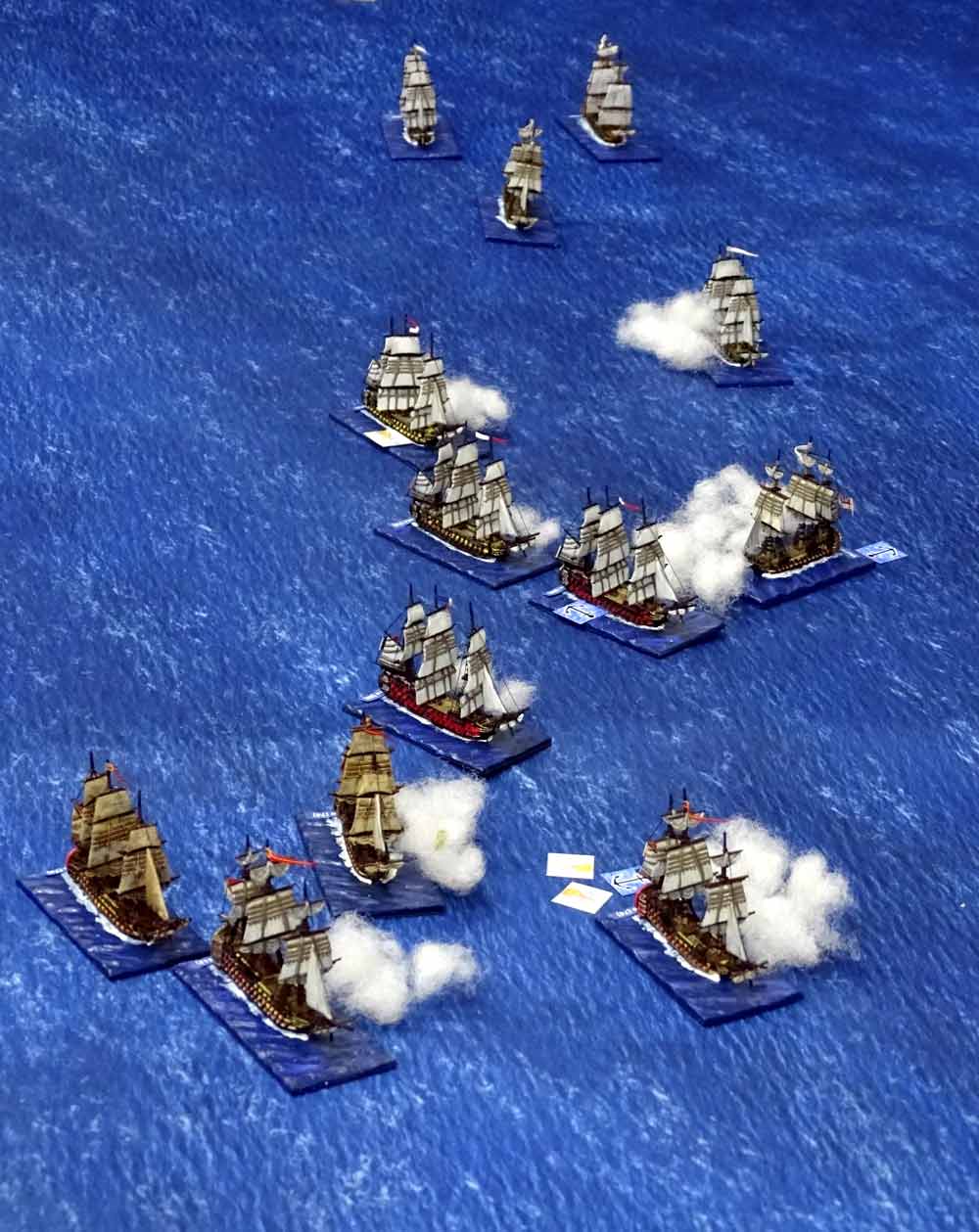 Then, all too suddenly, we were within proper gunnery range of each other. I thought I’d got my French ships into a good position, but while I chewed up my opponents, the British fire was even more effective, and my ships began to suffer. In the lead was my flagship Formidable (80 guns), which bore the brunt of the fire from Royal Sovereign and Colossus (74). Gyles though, came to my rescue.
Then, all too suddenly, we were within proper gunnery range of each other. I thought I’d got my French ships into a good position, but while I chewed up my opponents, the British fire was even more effective, and my ships began to suffer. In the lead was my flagship Formidable (80 guns), which bore the brunt of the fire from Royal Sovereign and Colossus (74). Gyles though, came to my rescue. 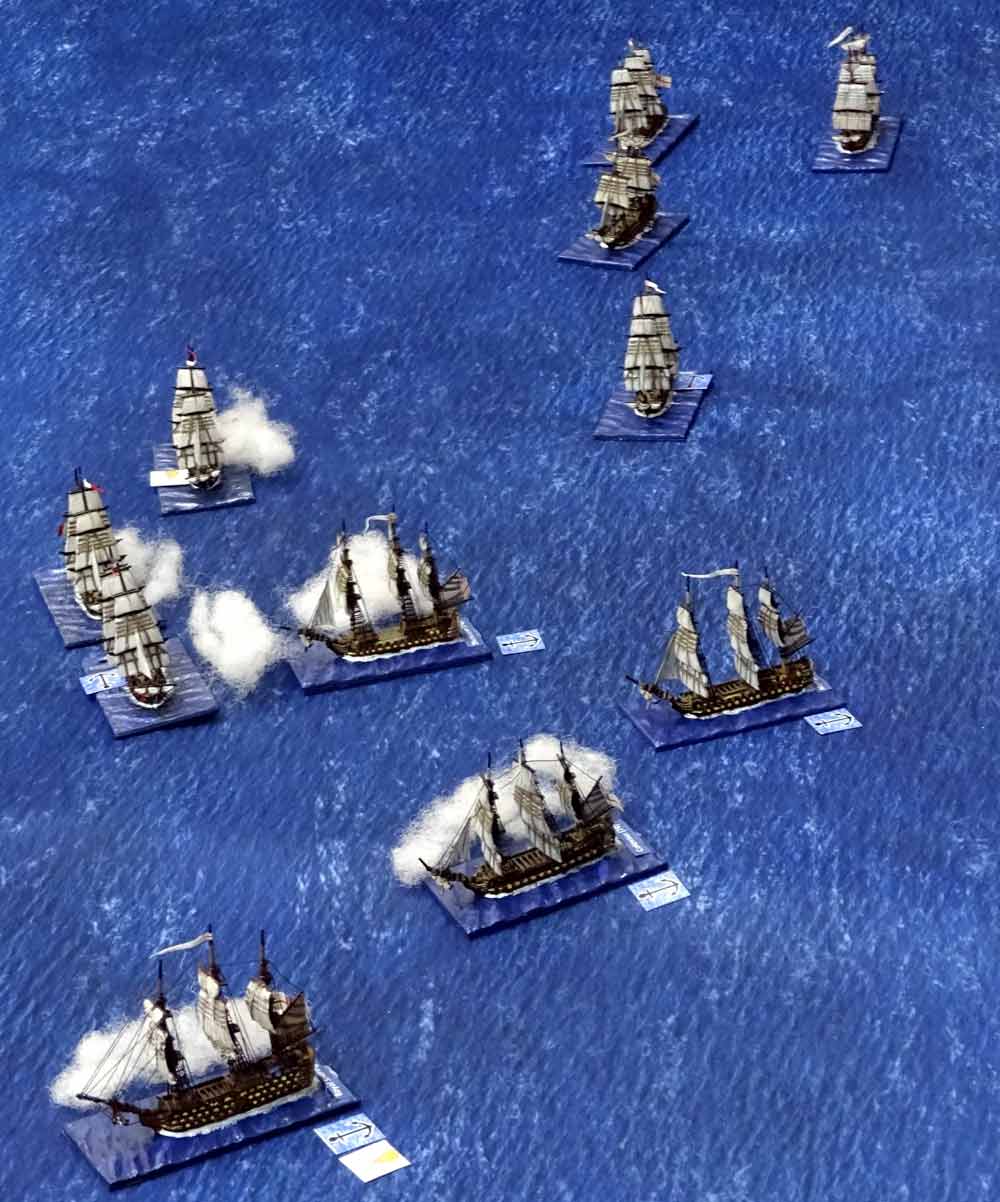 The Spanish began firing on the British flagship, with their own one, the Santa Anna (112) in the lead. For me though, despite raking the Thunderer (74), It was clear I was heading straight for the middle of the British squadron – and getting raked by the Royal Sovereign while I went. Ouch! The only saving grace was that Mally’s squadron of four ships-of-the-line still wasn’t in action.
The Spanish began firing on the British flagship, with their own one, the Santa Anna (112) in the lead. For me though, despite raking the Thunderer (74), It was clear I was heading straight for the middle of the British squadron – and getting raked by the Royal Sovereign while I went. Ouch! The only saving grace was that Mally’s squadron of four ships-of-the-line still wasn’t in action. 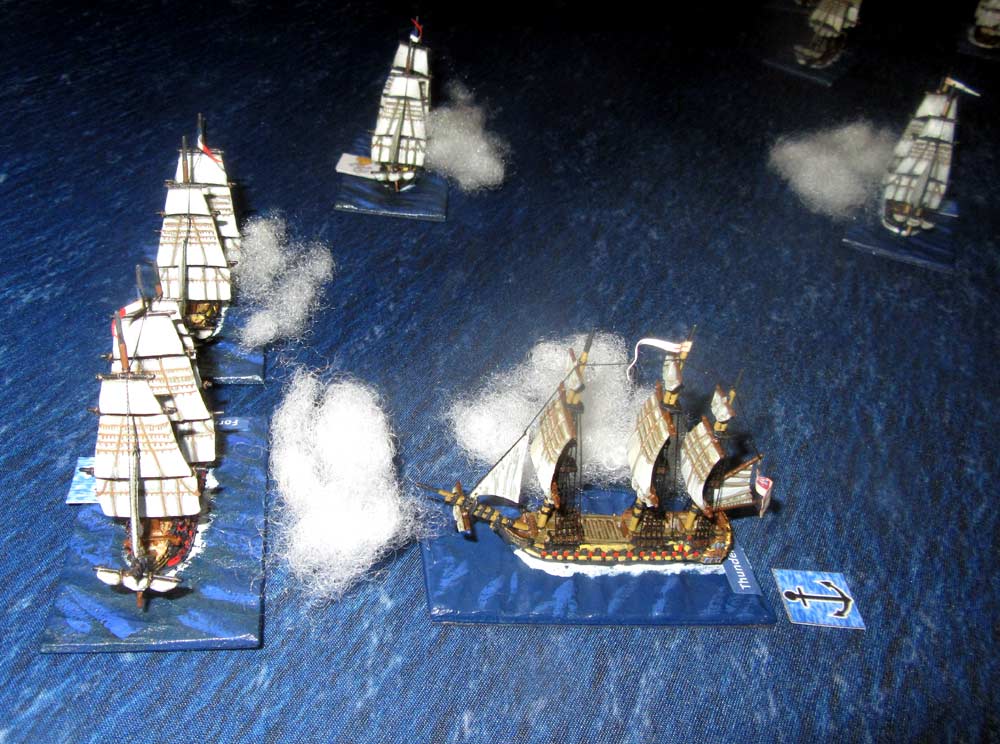 That was when things started to get messy. After plastering the Thunderer, the French ships turned to port, and weaved their way through the British ships. With the Spanish starting to do the same, we now had nine Allied ships against four British ones. Survival for Sean’s (or rather Collingwood’s) squadron was done to good firing, successful morale rolls, and hoping that Mally’s ships would reach him in time.
That was when things started to get messy. After plastering the Thunderer, the French ships turned to port, and weaved their way through the British ships. With the Spanish starting to do the same, we now had nine Allied ships against four British ones. Survival for Sean’s (or rather Collingwood’s) squadron was done to good firing, successful morale rolls, and hoping that Mally’s ships would reach him in time.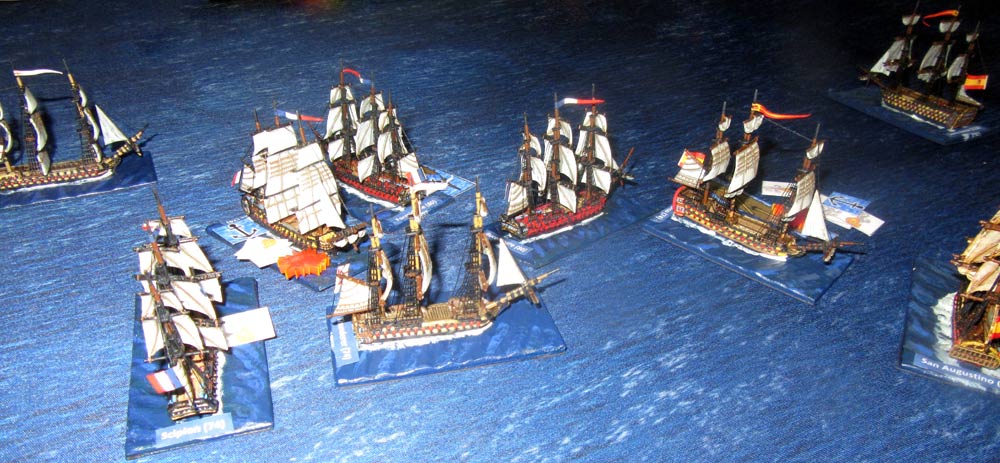 Instead, Sean started rolling badly, and the first to fall was the Royal Sovereign herself, which failed a morale check after being shredded at close range by three Spanish ships. So, she surrendered. Next to go though, was the Spanish Argonauta (74), which had just come alongside her. In this game we replaced ships which had struck with wreckage markers. These began popping up fast. The next to go was the Colossus, which was fired at by Formidable and Bucentaure (74). That made the tally two British ships struck, for one Spanish one. The French were next though, as the Redoutable (74) struck after taking a close-range broadside from Thunderer.
Instead, Sean started rolling badly, and the first to fall was the Royal Sovereign herself, which failed a morale check after being shredded at close range by three Spanish ships. So, she surrendered. Next to go though, was the Spanish Argonauta (74), which had just come alongside her. In this game we replaced ships which had struck with wreckage markers. These began popping up fast. The next to go was the Colossus, which was fired at by Formidable and Bucentaure (74). That made the tally two British ships struck, for one Spanish one. The French were next though, as the Redoutable (74) struck after taking a close-range broadside from Thunderer.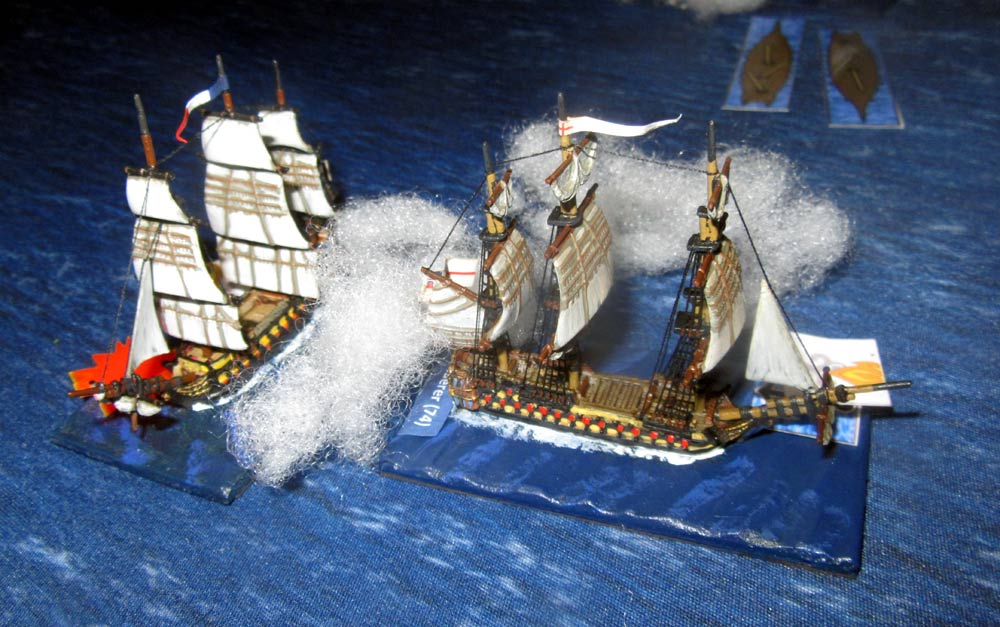 The Scipion (74) managed to rake Thunderer in turn, but my gunnery was dreadful. So, Thunderer stayed in the fight, despite being surrounded by enemy ships. By now, Mally’s ships had finally joined the fight. However, Bucentaure, firing to both sides, hit Mars and raked Mally’s Bellerophon, which struck. With that the Allies decided to break off the action, before Mally could turn the tide. So, that’s where we ended the action. The game was duly declared a draw, with three British ships struck, and two Allied ones – a French ship and a Spanish one. Yes I know – this was a rather unlikely outcome, but the British were ganged up on! The game itself though, rolled along nicely. While I still have reservations, the rules worked well on the night, and above all they were great fun to play.
The Scipion (74) managed to rake Thunderer in turn, but my gunnery was dreadful. So, Thunderer stayed in the fight, despite being surrounded by enemy ships. By now, Mally’s ships had finally joined the fight. However, Bucentaure, firing to both sides, hit Mars and raked Mally’s Bellerophon, which struck. With that the Allies decided to break off the action, before Mally could turn the tide. So, that’s where we ended the action. The game was duly declared a draw, with three British ships struck, and two Allied ones – a French ship and a Spanish one. Yes I know – this was a rather unlikely outcome, but the British were ganged up on! The game itself though, rolled along nicely. While I still have reservations, the rules worked well on the night, and above all they were great fun to play. 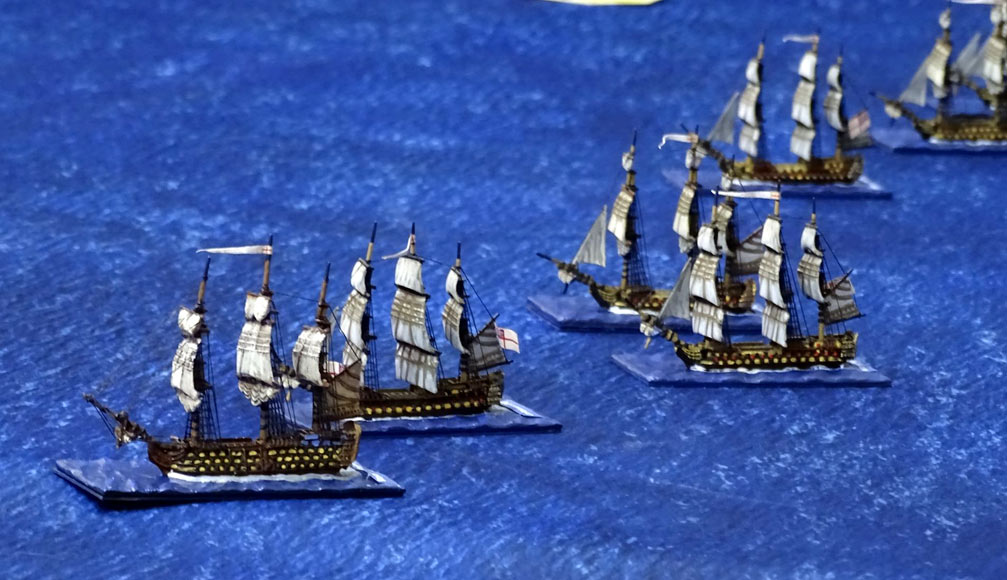


Great looking game. I will have to check the FB group for those rule ammendments.
Thanks Stephen. Yes, those amendments really turned the rules around. Even then, expect to tinker a bit with the stats.
Super looking game…..the table looks good too. What sort of mat is it?
A watery one, Michael! Actually, I don’t know. Mine is a North Sea or North Atlantic grey, while this more Caribbean one was borrowed from my pal Sean. I’ll ask him and report back… It’s certainly pretty.